Wildflowers of the Adirondacks:
White Baneberry (Actaea pachypoda)
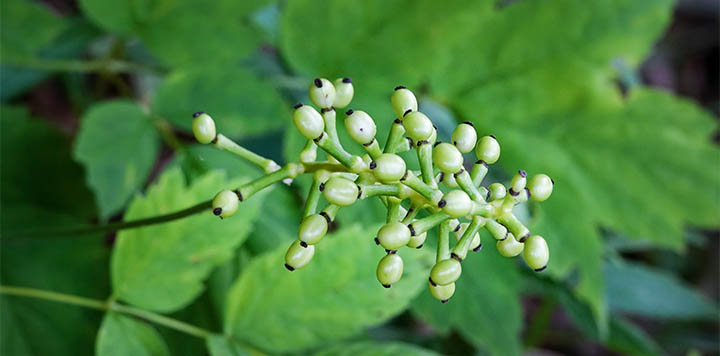
White Baneberry (Actaea pachypoda) is a native wildflower that grows in the Adirondack Mountains of upstate New York and produces striking white berries in late summer.
White Baneberry is a member of the Buttercup Family (Ranunculaceae). It is one of three species in the genus Actaea (Baneberry) found within the Adirondack Park. The other two are Red Baneberry and Louis's Baneberry.
- Red Baneberry (Actaea rubra) is a closely-related plant with very similar leaves and flowers, found in similar upland habitats throughout the Adirondack Park, although its late-summer berries are usually red, rather than white.
- Louis's Baneberry (Actaea pachypoda × A. rubra = A. ×ludovici B. Boivin) is listed by the New York Flora Atlas as present in Franklin, Essex, Warren, Saratoga, and Oneida counties. This is apparently the same plant that other sources treat as a form of White Baneberry (Actaea pachypoda forma rubrocarpa).
The species name – pachypoda – is said to be from the Greek words "packy" (meaning thick) and "poda" (feet) and derives from the thick flower and berry stalks. The author name (Elliot) is a reference to Stephen Elliot, an American botanist who lived in the late 18th and early 19th centuries. An older scientific name for the plant is Actaea alba.
- The nonscientific name for this species – White Baneberry – is a reference to the shiny white berry seen in late summer after the plant flowers.
- Other nonscientific names for White Baneberry include White Cohosh, White-beads, White Beads, Toadroot, Doll's Eyes, and Dolls-eyes. The latter names are a reference to the fact that the white berries have a prominent dark stigma
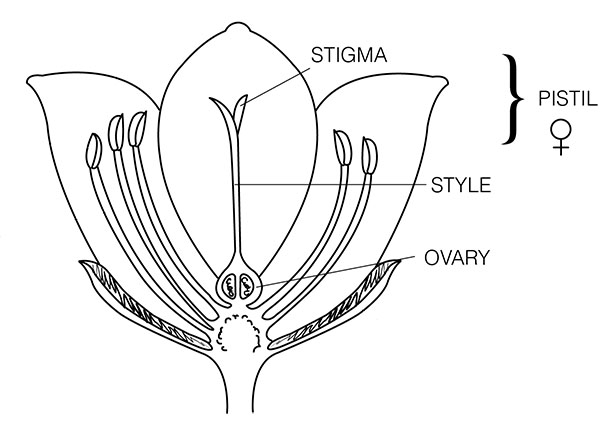 Stigma: part of the pistil, which is the seed-producing, or female, unit of a flower. The stigma is the tip of the pistil, where the pollen lands. in the center and, as a result, resemble the eyes of old-fashioned china dolls.
Stigma: part of the pistil, which is the seed-producing, or female, unit of a flower. The stigma is the tip of the pistil, where the pollen lands. in the center and, as a result, resemble the eyes of old-fashioned china dolls.
Identification of White Baneberry
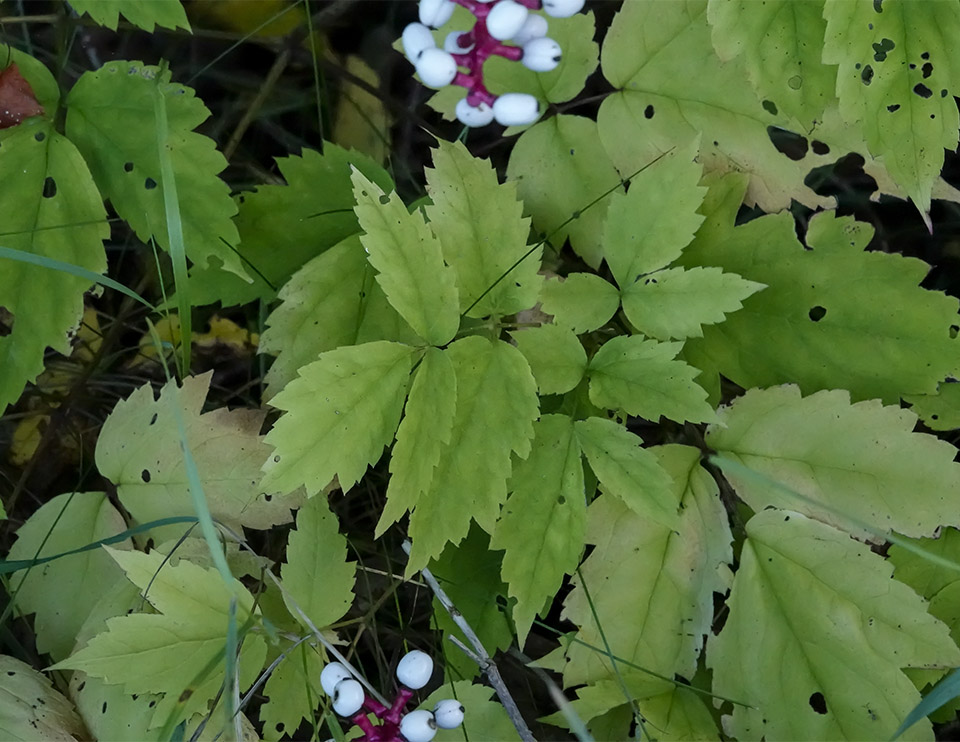
White Baneberry is an erect perennial, between one and two feet high. The stems are green and hairless, usually purplish at the nodeNode: The place on a stem from which a leaf or a branch grows..
White Baneberry leaves are alternate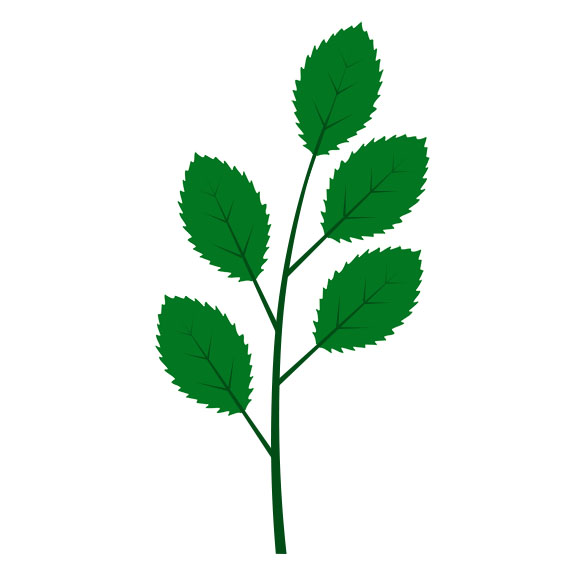 Alternate: An arrangement of leaves (or buds) on a stem (or twig) in which the leaves emerge from the stem one at a time. This often makes the leaves appear to alternate on the stem., meaning that they emerge from the stem one at a time, not in pairs.
Alternate: An arrangement of leaves (or buds) on a stem (or twig) in which the leaves emerge from the stem one at a time. This often makes the leaves appear to alternate on the stem., meaning that they emerge from the stem one at a time, not in pairs.
- The leaves are
compound
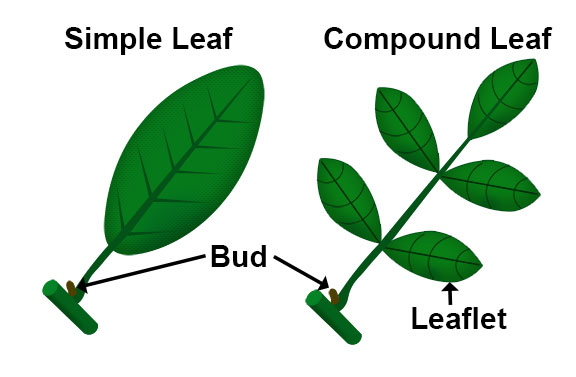 Compound Leaf: A leaf that is divided to the midrib, with distinct, expanded portions called leaflets., which means that each leaf is divided into leaflets.
Compound Leaf: A leaf that is divided to the midrib, with distinct, expanded portions called leaflets., which means that each leaf is divided into leaflets. - Each leaflet is up to four inches long and 2¼ inches wide.
- The
margin The structure of the leaf's edge.
(edge) of the leaflets are sharply and coarsely
toothed
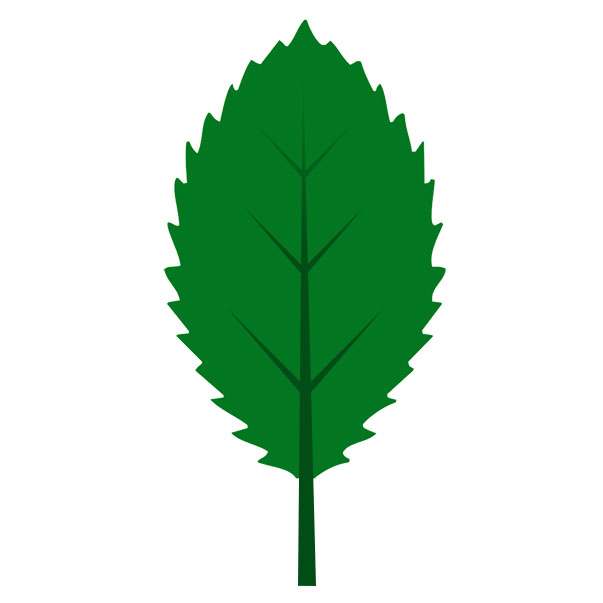 Toothed: Leaves which have a saw-toothed edge..
Toothed: Leaves which have a saw-toothed edge..
- Both the upper and lower surfaces of each leaflet are usually hairless.
- The leaves are green during the summer, usually changing to yellow or becoming splotched with yellow in the fall when the berries have developed.
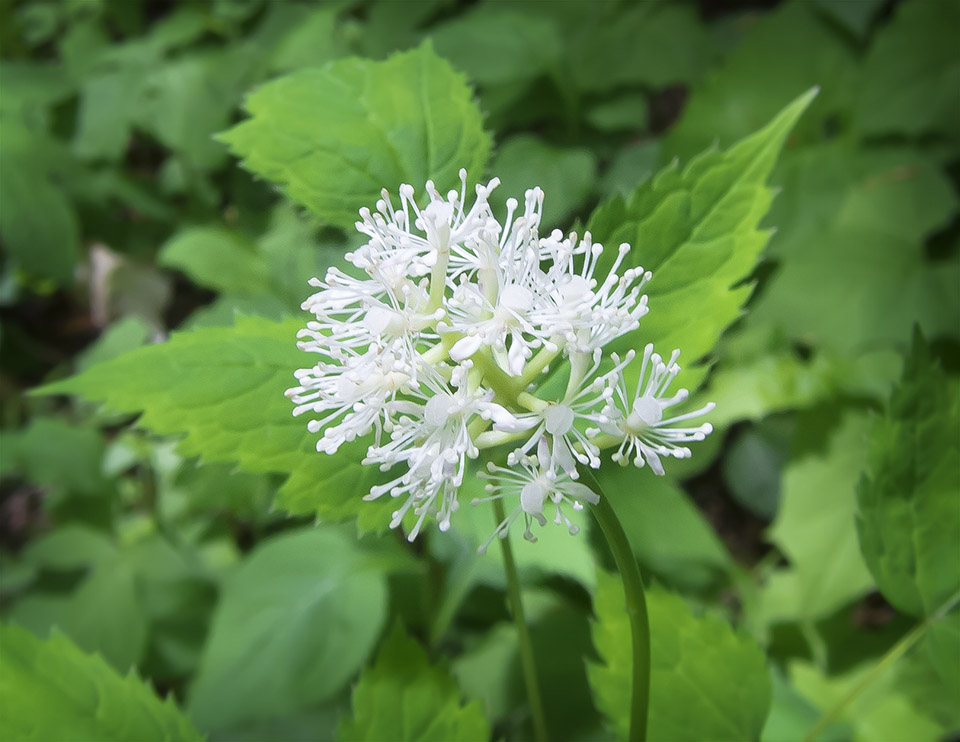
The flowers of White Baneberry grow in a dense cluster (inflorescence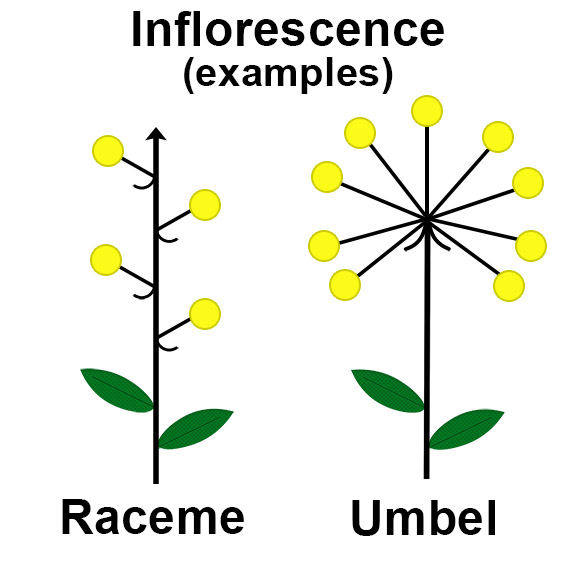 Inflorescence: A group or cluster of flowers arranged on a stem. ) at the end of a long stem that rises above the leaves. The flower cluster is initially cylindrical in shape, about 1½–3" long, but becomes longer when the flowers fade and are replaced by berries.
Inflorescence: A group or cluster of flowers arranged on a stem. ) at the end of a long stem that rises above the leaves. The flower cluster is initially cylindrical in shape, about 1½–3" long, but becomes longer when the flowers fade and are replaced by berries.
The individual flowers are tiny, ¼ to ½ inch across. Each flower emerges at the end of a short, very thick flower stalk (pedicel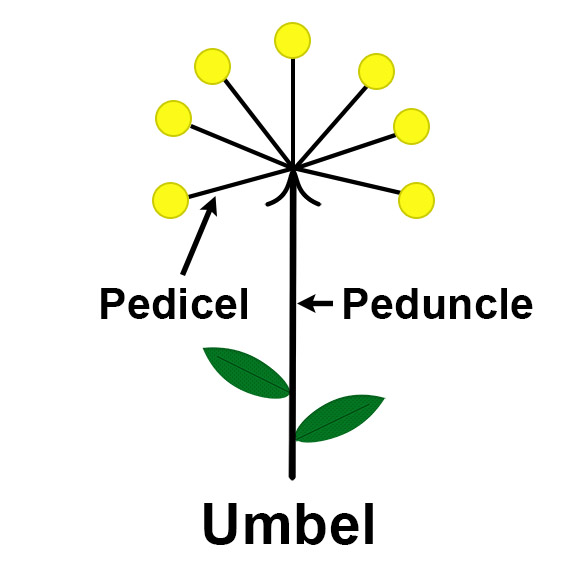 Pedicel: A small stalk bearing an individual flower in an inflorescence (flower cluster). ). The thickness of the flower stalks is not always apparent when the plant begins to flower, but becomes easier to discern when the flower cluster matures. Each flower has 4 to 10 narrow white petals, which fall off early, leaving a dozen or more white stamens
Pedicel: A small stalk bearing an individual flower in an inflorescence (flower cluster). ). The thickness of the flower stalks is not always apparent when the plant begins to flower, but becomes easier to discern when the flower cluster matures. Each flower has 4 to 10 narrow white petals, which fall off early, leaving a dozen or more white stamens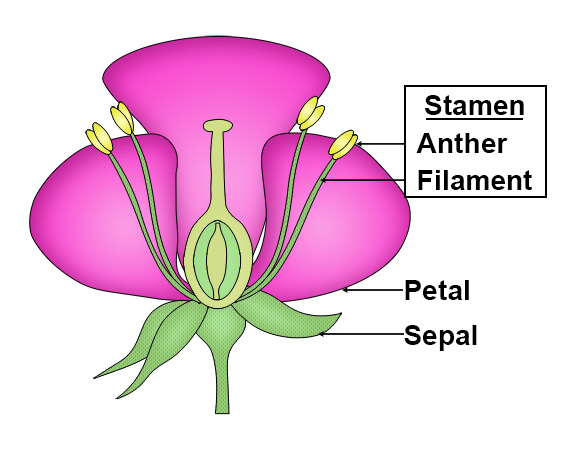 Stamen: The male part of the flower, made up of the filament and anther., and a short, thick style
Stamen: The male part of the flower, made up of the filament and anther., and a short, thick style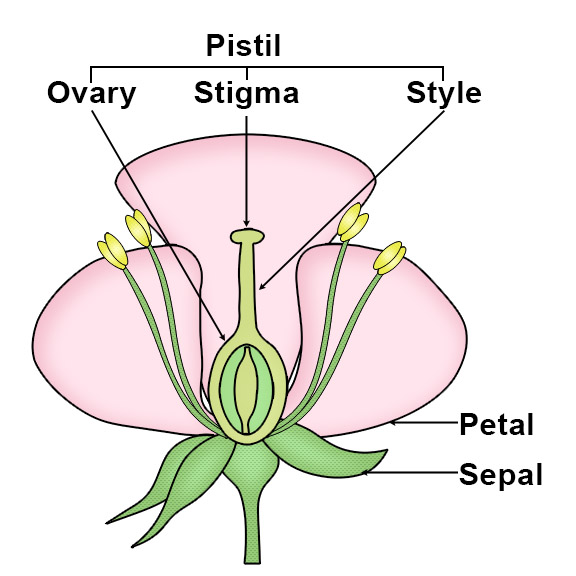 Style: The narrow, elongated part of the pistil between the ovary and the stigma. The style is part of the pistil (the female organs of a flower), which also consists of an ovary and a stigma. The style is the stalk that connects the stigma to the ovary.. At the end of the style is a large stigma
Style: The narrow, elongated part of the pistil between the ovary and the stigma. The style is part of the pistil (the female organs of a flower), which also consists of an ovary and a stigma. The style is the stalk that connects the stigma to the ovary.. At the end of the style is a large stigma Stigma: part of the pistil, which is the seed-producing, or female, unit of a flower. The stigma is the tip of the pistil, where the pollen lands. , which is white when the flowers start to bloom, but which later darkens as the flowers are replaced by fruit.
Stigma: part of the pistil, which is the seed-producing, or female, unit of a flower. The stigma is the tip of the pistil, where the pollen lands. , which is white when the flowers start to bloom, but which later darkens as the flowers are replaced by fruit.
The flowering season for White Baneberry throughout its range is May to June, lasting about two weeks. In the Adirondacks, White Baneberry normally flowers in early June.
White Baneberry flowers are replaced by fruit, starting in early August. The fruit takes the form of berries, which are about ⅓ inches in length. The berries start off green, usually changing to greenish white. The fruit stalk (pedicel Pedicel: A small stalk bearing an individual flower in an inflorescence (flower cluster). ) is thick and gradually turns pink or red. The berry has an "eye" in the center, formed by the stigma
Pedicel: A small stalk bearing an individual flower in an inflorescence (flower cluster). ) is thick and gradually turns pink or red. The berry has an "eye" in the center, formed by the stigma Stigma: part of the pistil, which is the seed-producing, or female, unit of a flower. The stigma is the tip of the pistil, where the pollen lands. . Each berry contains several hard cone-shaped or wedge-shaped seeds, which are dark brown to reddish brown in color. The fruit is usually fully mature in our area by the end of August. As the fruit develops, the cluster tends to lengthen; the fruit stalks thicken and turn pinkish and then bright red.
Stigma: part of the pistil, which is the seed-producing, or female, unit of a flower. The stigma is the tip of the pistil, where the pollen lands. . Each berry contains several hard cone-shaped or wedge-shaped seeds, which are dark brown to reddish brown in color. The fruit is usually fully mature in our area by the end of August. As the fruit develops, the cluster tends to lengthen; the fruit stalks thicken and turn pinkish and then bright red.
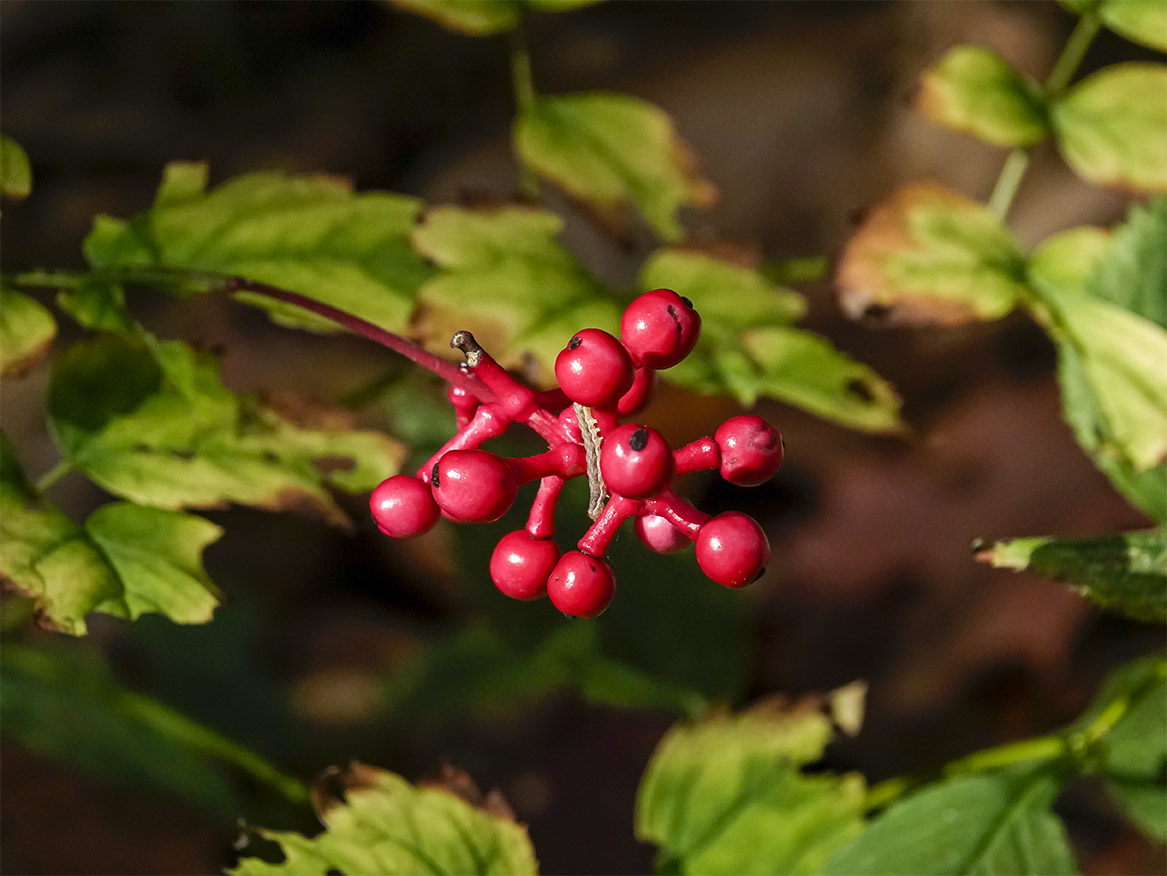
Although most White Baneberry plants bear white berries, there is a red-fruited form. Sources conflict on whether this plant is a form of White Baneberry (Actaea pachypoda forma rubrocarpa) or a hybrid (Actaea pachypoda × Actaea rubra → Actaea ×ludovici Boivin). In any case, most sources agree that the plant is generally rare, but distinguished from Red Baneberry (Actaea rubra) by the fact that the fruit stalks are very thick and bright red in color.
The distribution of the red-berried form in the Adirondacks is not known. Kudish (1992) states that White Baneberry plants found on Baxter Mountain in Keene Valley and on Baldface Mountain had pink, rather than white, fruits. Schottman (1998) also reports finding a fat-stalked, red-berried baneberry in the Adirondacks. Red fruits were also found on several plants on the Heaven Hill Trails near Lake Placid.
White Baneberry is most likely to be confused with a closely related plant: Red Baneberry. The latter plant has very similar fluffy white flowers blooming at about the same time. The leaves, which are alternate and compound, are also very similar. In the case of Red Baneberry, the berry-like fruit is generally a deep, vibrant red, as opposed to white. However, as noted above, some specimens of White Baneberry bear red berries; and (just to complicate matters) some specimens of Red Baneberry bear white berries.
The main way of distinguishing the two baneberry species, whether in flower or in fruit, is the thickness of the flower stalk (pedicel Pedicel: A small stalk bearing an individual flower in an inflorescence (flower cluster). ). The flower stalks of White Baneberry are noticeably thicker than the slender flower stalks of Red Baneberry. This difference is most pronounced after the flowers fade and are replaced by fruit. As noted above, the stalks supporting White Baneberry fruit thicken and turn a bright red. This feature helps distinguish the red form of White Baneberry from Red Baneberry.
Pedicel: A small stalk bearing an individual flower in an inflorescence (flower cluster). ). The flower stalks of White Baneberry are noticeably thicker than the slender flower stalks of Red Baneberry. This difference is most pronounced after the flowers fade and are replaced by fruit. As noted above, the stalks supporting White Baneberry fruit thicken and turn a bright red. This feature helps distinguish the red form of White Baneberry from Red Baneberry.
There are also less obvious differences between the two species. The berries of Red Baneberry reportedly contain more seeds (ten or more) and smaller seeds than those of White Baneberry. Moreover, Red Baneberry is said to usually have somewhat hairy leaves, while the leaves of White Baneberry are usually hairless. Some sources suggest that the shape of the flower cluster is somewhat different, with those of Red Baneberry rounder than the slightly more elongated flower clusters of White Baneberry. This difference, however, is not definitive as the shape of White Baneberry's flower cluster changes as the flowers mature.
Uses of White Baneberry
White Baneberry is not an edible plant. All sources agree that White Baneberry (like Red Baneberry) is poisonous. All parts of the plant are toxic. The berries are considered to be especially poisonous; and large quantities may cause cardiac arrest or respiratory paralysis if consumed. Other symptoms include severe stomach cramps, dizziness, headache, diarrhea, and hallucinations.
Despite the plant's toxic properties, it was used by several native American groups for medicinal purposes. The Blackfoot, for instance, are said to have used a decoction of root for colds and coughs. The Cherokee reportedly used an infusion of the root for itching and as a gargle. The Chippewa are said to have used a decoction of roots as a remedy for convulsions.
Wildlife Value of White Baneberry
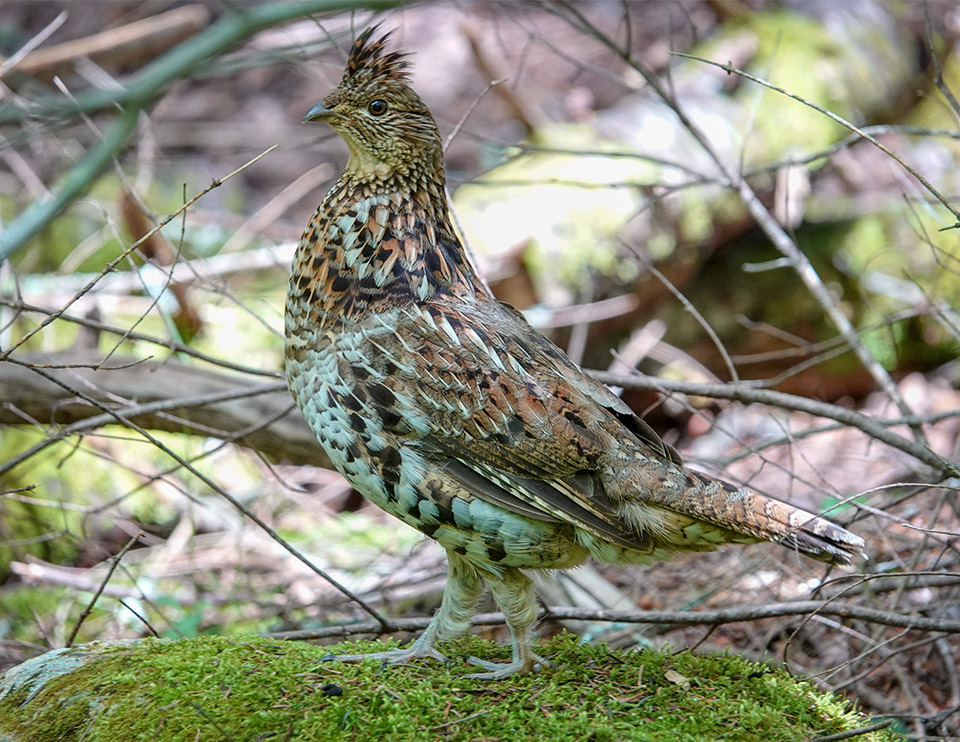
White Baneberry is not a major food source for wildlife. The flowers do not have nectar, offering only pollen to visiting insects. The pollen is collected mainly by short-tongued bees. Most bees seen on the flowers are Halictid species (including Agapostemon splendens and Halictus rubicundus). The bees are said to collect the pollen for feeding their larvae. Other insects that feed on the pollen include wasps, flies, and beetles. Some flies and beetles are non-pollinating.
Although the fruit is highly toxic to humans, small quantities of baneberry fruits reportedly are consumed by several species of birds, including Ruffed Grouse, Yellow-bellied Sapsuckers, and American Robins, apparently with no ill effects. Small mammals, such as White-footed Mice and Red-backed Moles, reportedly also consume the berries, sometimes removing the pulp and eating only the seeds. Baneberry fruit which disappears at night has usually been eaten by rodents.
Distribution of White Baneberry
White Baneberry is found in the eastern half of the US and southern Canada. It grows in Ontario east to Nova Scotia, south to Florida, west to Louisiana and Oklahoma, and north to Nebraska and Minnesota. The plant is listed as Endangered in Florida and Exploitably Vulnerable in New York State.
White Baneberry is found in almost all counties throughout New York State. Its presence has been confirmed by vouchered plant specimens in all counties within the Adirondack Park Blue Line, with the exception of Saratoga County.
Habitat of White Baneberry
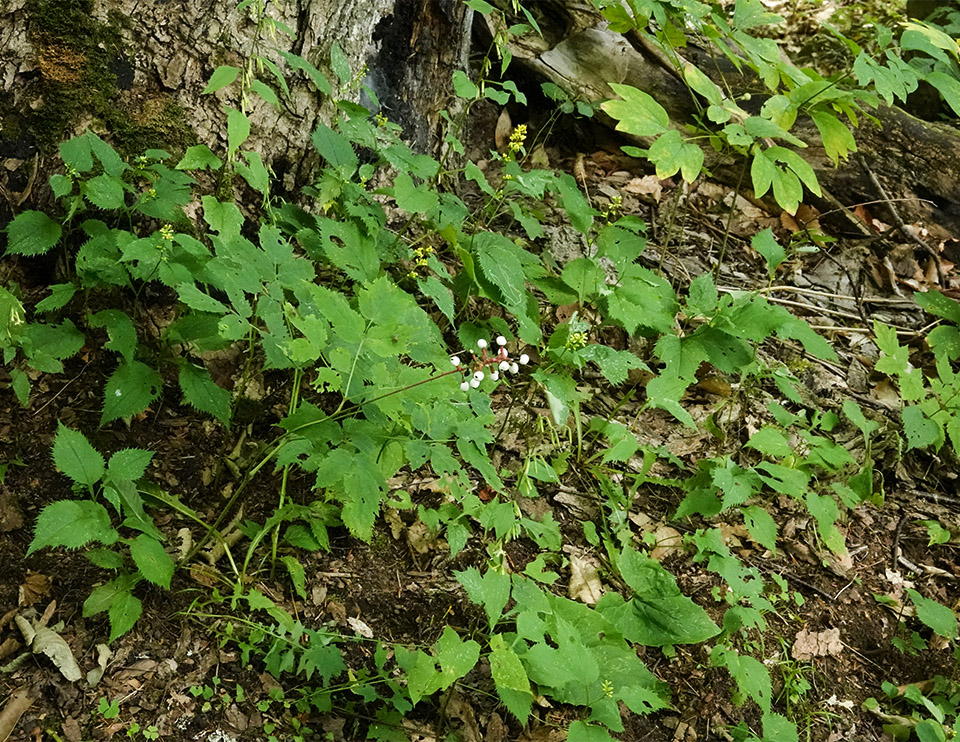
White Baneberry is shade-tolerant and can grow in dappled sunlight to medium shade. If exposed to excessive sunlight, the leaves may become yellowish.
White Baneberry is an Obligate Upland plant, meaning that it almost never occurs in wetlands.
- White Baneberry is most frequently found in rich mesic forests, often under northern hardwoods.
- The species often occurs in somewhat richer sites than Red Baneberry, although the two plants are frequently seen growing in close proximity to one another.
- White Baneberry also grows, but less frequently, in mixed forests with conifers.
In the Adirondacks, ecological communities in which White Baneberry is found include Calcareous Talus Slope Woodland and Maple-Basswood Rich Mesic Forest. Among the trails covered here, the most convenient places to look for White Baneberry are the Big Field Loop and the Sugar Maple Trail at Heaven Hill, and the Rocky Knob Trail at Henry's Woods. White Baneberry plants are often found growing under hardwoods, such as Yellow Birch and Sugar Maple, near other plants that flourish in northern hardwood forests, such as Blue Cohosh and Maidenhair Fern.
References
Michael Kudish. Adirondack Upland Flora: An Ecological Perspective (The Chauncy Press, 1992), p. 107.
New York Flora Association. New York Flora Atlas. White Baneberry. Actaea pachypoda. Retrieved 21 October 2019.
New York Flora Association. New York Flora Atlas. Louis’s Baneberry. Actaea pachypoda × A. rubra = A. ×ludovici B. Boivin. Retrieved 22 October 2019.
Integrated Taxonomic Information System. Actaea pachypoda. Retrieved 21 October 2019.
United States Department of Agriculture. The Plants Database. White Baneberry. Actaea pachypoda Elliott. Retrieved 21 October 2019.
Flora of North America. Actaea pachypoda Elliott. Retrieved 21 October 2019.
NatureServe Explorer. Online Encyclopedia of Life. White Baneberry. Actaea pachypoda. Retrieved 21 October 2019.
Native Plant Trust. Go Botany. Doll's-eyes. Actaea pachypoda Ell. Retrieved 21 October 2019.
New York State. Department of Environmental Conservation. New York Natural Heritage Program. Ecological Communities of New York State. Second Edition (March 2014), pp. 107, 120-121. Retrieved 17 October 2015.
New York Natural Heritage Program. 2019. Online Conservation Guide for Calcareous Talus Slope Woodland. Retrieved 27 January 2019.
New York Natural Heritage Program. 2019. Online Conservation Guide for Maple-Basswood Rich Mesic Forest. Retrieved 27 January 2019.
New York State. Adirondack Park Agency. Preliminary List of Species Native Within the Adirondack Park Listed Alphabetically by Scientific Name and Sorted by Habit. Volume 1. Updated 10.23.2006, p.13. Retrieved 26 January 2017.
USA National Phenology Network. Nature’s Notebook. Actaea pachypoda. Retrieved 21 October 2019.
Connecticut Botanical Society. White Baneberry. Actaea pachypoda Ell. Retrieved 21 October 2019.
University of Wisconsin. Flora of Wisconsin. Actaea pachypoda Elliott. Retrieved 21 October 2019.
Minnesota Wildflowers. Plant Name. Actaea pachypoda. White Baneberry. Retrieved 21 October 2019.
Illinois Wildflowers. Doll's Eyes. Actaea pachypoda. Retrieved 21 October 2019.
Illinois Wildflowers. Insect Visitors of Illinois Wildflowers. Flower-Visiting Insects of Doll's Eyes. Retrieved 21 October 2019.
Eloise Butler Wildflower Garden. The Friends of the Wild Flower Garden. White Baneberry. Actaea pachypoda Elliot. Retrieved 21 October 2019.
Lady Bird Johnson Wildflower Center. Actaea pachypoda. Retrieved 21 October 2019.
iNaturalist. Adirondack Park Observations. White Baneberry. Retrieved 20 October 2019.
Anne McGrath. Wildflowers of the Adirondacks (EarthWords, 2000), p. 9, Plate 4.
Carol Gracie. Spring Wildflowers of the Northeast. A Natural History (Princeton University Press, 2012), pp. 2-4, 243-244.
Roger Tory Peterson and Margaret McKenny. A Field Guide to Wildflowers. Northeastern and North-central North America (Houghton Mifflin Company, 1968), pp. 54-55. Retrieved 21 October 2019.
Doug Ladd. North Woods Wildflowers (Falcon Publishing, 2001), p. 212.
Lawrence Newcomb. Newcomb's Wildflower Guide (Little Brown and Company, 1977), pp. 424-425.
David M. Brandenburg. Field Guide to Wildflowers of North America (Sterling Publishing Company, Inc., 2010), p. 454.
Timothy Coffey. The History and Folklore of North American Wildflowers (FactsOnFile, 1993), pp. 8-9.
Ruth Schottman. Trailside Notes. A Naturalist's Companion to Adirondack Plants (Adirondack Mountain Club, 1998), pp. 65-68.
William Carey Grimm. The Illustrated Book of Wildflowers and Shrubs (Stackpole Books, 1993), pp. 104-105.
Wilbur H. Duncan and Marion B. Duncan. Wildflowers of the Eastern United States (The University of Georgia Press, 1999), p. 13, Plate 43.
National Audubon Society. Field Guide to North American Wildflowers. Eastern Region. (Alfred A. Knopf, 2001), pp. 721-722, Plate 112.
William K. Chapman et al. Wildflowers of New York in Color (Syracuse University Press, 1998), p. 42.
Alexander C. Martin, Herbert S. Zim, and Arnold L. Nelson. American Wildlife & Plants. A Guide to Wildlife Food Habits (Dover Publications, 1951), p. 396.
John Eastman. The Book of Forest and Thicket: Trees, Shrubs, and Wildflowers of Eastern North America (Stackpole Books, 1992), pp. 12-13.
Plants for a Future. Actaea pachypoda. Retrieved 21 October 2019.
Steven Foster and James A. Duke. A Field Guide to Medicinal Plants and Herbs of Eastern and Central North America. Second Edition. (Houghton Mifflin Harcourt, 2000), pp. 60-61.
University of Michigan. Native American Ethnobotany. A Database of Foods, Drugs, Dyes and Fibers of Native American Peoples, Derived from Plants. White Baneberry. Actaea pachypoda Ell. Retrieved 21 October 2019.
Steven Clemants and Carol Gracie. Wildflowers in the Field and Forest: A Field Guide to the Northeastern United States (Oxford University Press, 2006), pp. 384-385.
Charles H. Peck. Plants of North Elba. (Bulletin of the New York State Museum, Volume 6, Number 28, June 1899). Retrieved 22 February 2017.
Charles Robertson, "Flowers and Insects. XVIII," Botanical Gazette, Volume 25, Number 4 (April 1898), pp. 229-245. Retrieved 21 October 2019.
Richard S. Mitchell and J. Kenneth Dean. Ranunculaceae (Crowfoot Family) of New York State (Bulletin of the New York State Museum, Bulletin Number 446, 1982), pp. 10-13. Retrieved 22 October 2019.
James A. Compton and Alastair Culham, "Neotypification of Actaea pachypoda Elliott (Ranunculaceae)," Taxon, Volume 53, Number 1 (February 2004), pp. 163-165. Retrieved 22 October 2019.
